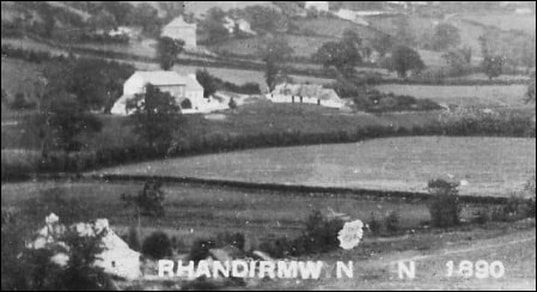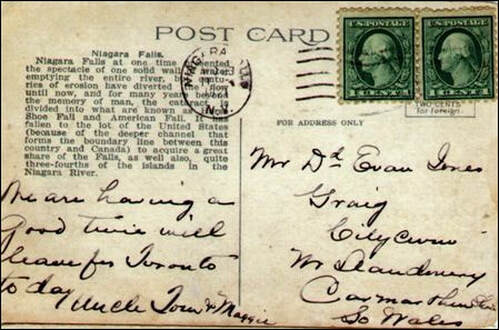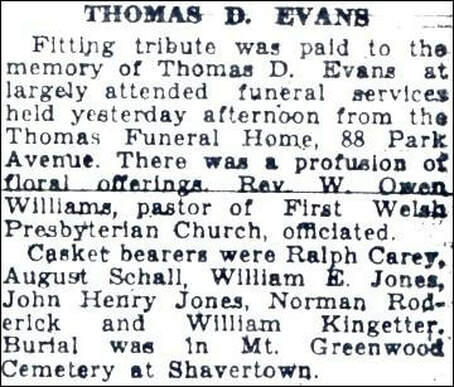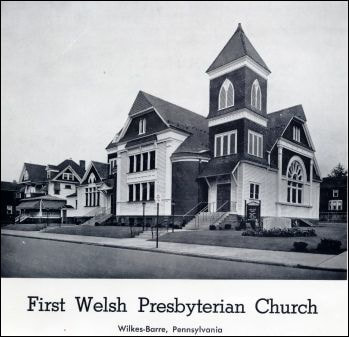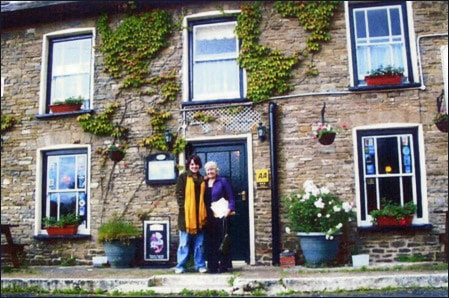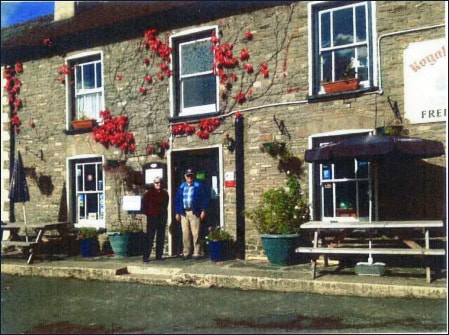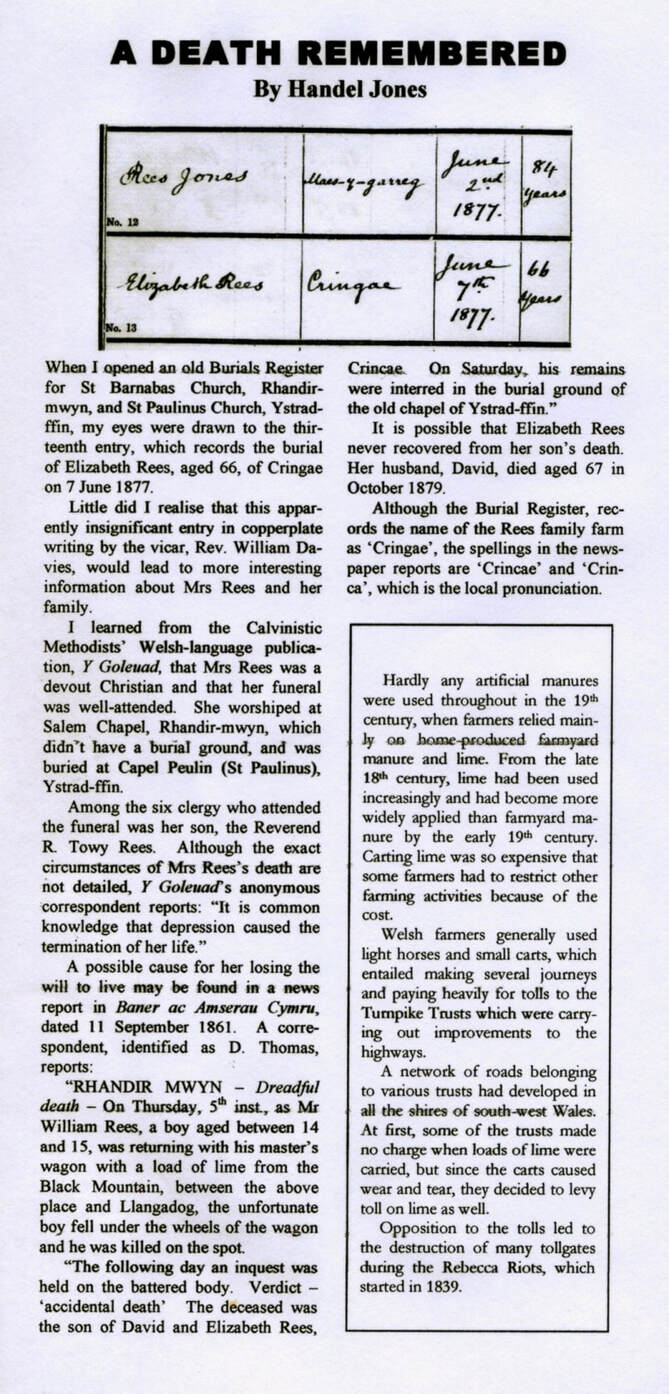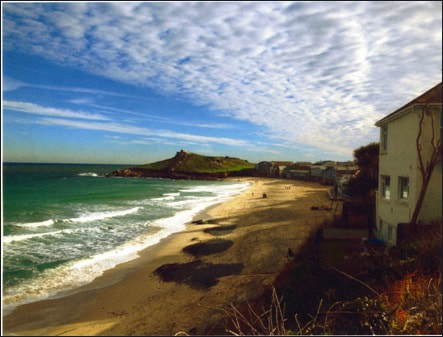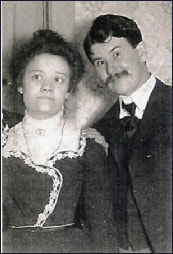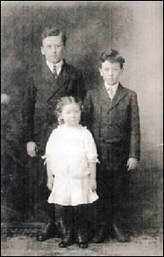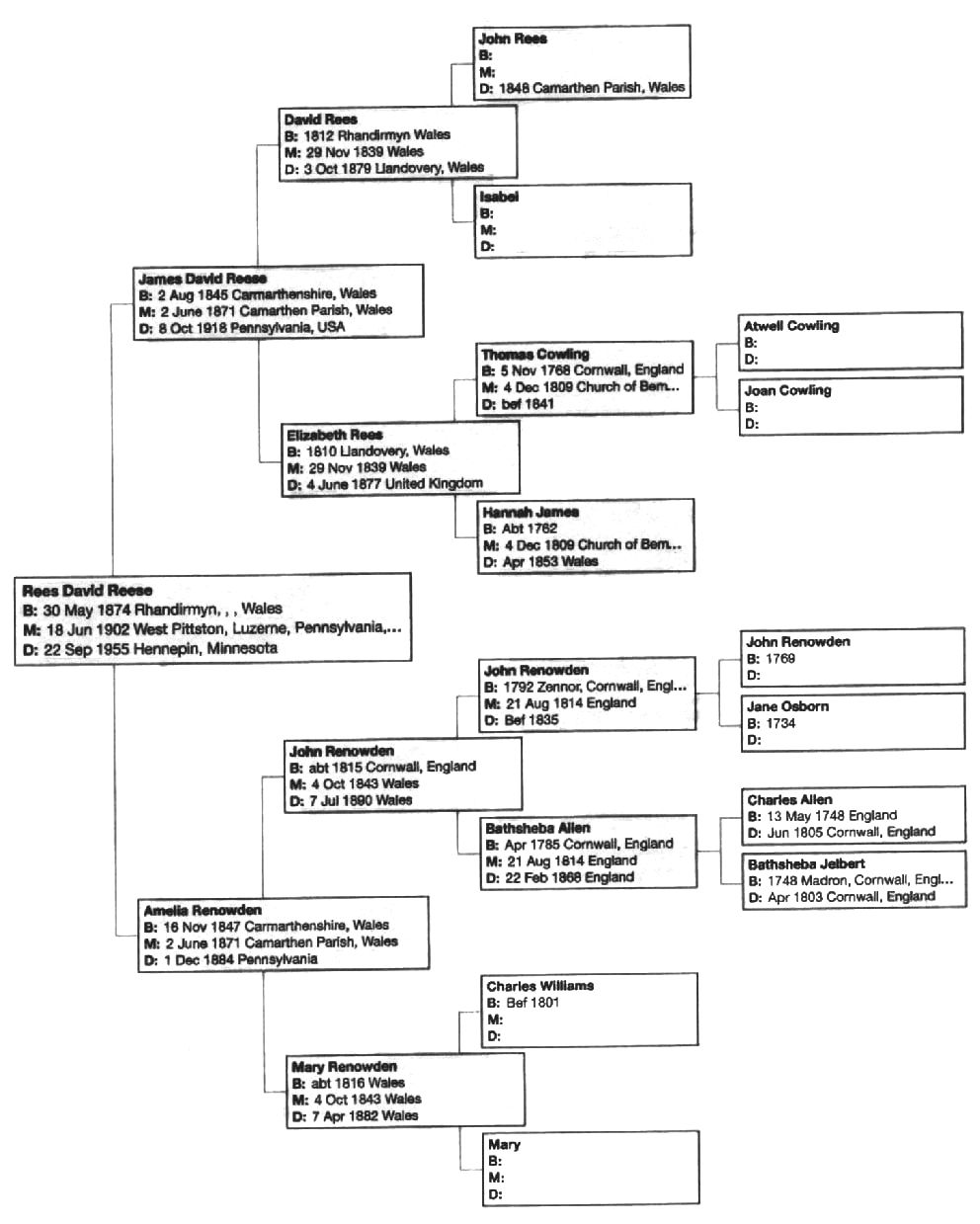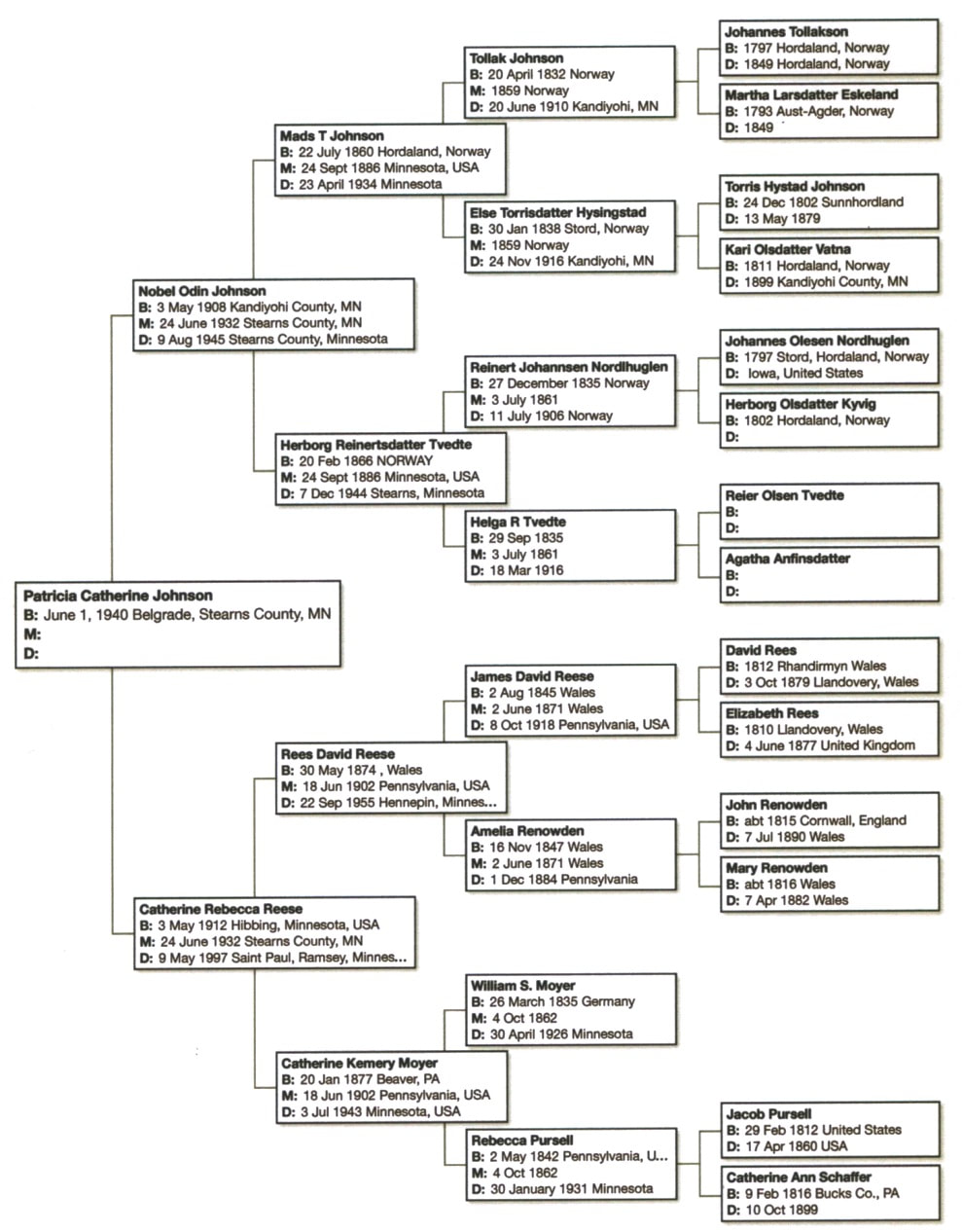Welcome
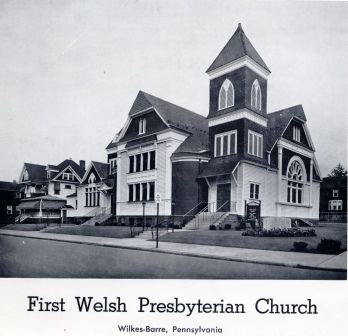
You are probably perplexed as to why there should be a page called America on this website which is about a small village in Wales. One word links Rhandirmwyn and America and that is mining. The hard rock lead miners were well suited to work in the anthracite mines of America and in the mid to late1800’s many left for a better life in this wonderful place full of promises and wealth. You would be surprised as to how many left this beautiful valley to start a new life there. Most settled in the State of Pennsylvania in Scranton and Wilkes-Barre which were anthracite mining areas. Others settled in other states also. If you are a descendant or relative of anyone who left this area then I would love to hear from you. Are you searching for relatives who left for America, or are you living there or anywhere else for that matter and looking for your ancestors who originated from Rhandirmwyn or the upper Tywi (Towy) valley. Let me have your story.
Many who left ended up as miners but others went in search of other vocations and did very well. Here are the stories of some of these people. There are many more which will be included in due course.
Many who left ended up as miners but others went in search of other vocations and did very well. Here are the stories of some of these people. There are many more which will be included in due course.
Thomas D Evans - Morgan B Williams - Renowden & Rees - John T Williams - William R Lewis & Jane ‘Jenny’ Lewis
From Rhandirmwyn to Pennsylvania
The story of Thomas D. Evans and his family
Thomas D. Evans was born in Gwernhirion, Rhandirmwyn on the 10th May 1864. He was the son of Daniel and Mary and brother to my great grandmother Sarah. His father Daniel worked for the Nantymwyn lead mine company as a miner. Thomas also went to work in the mine at a young age.
The 1881 census confirms this.
Thomas D. Evans was born in Gwernhirion, Rhandirmwyn on the 10th May 1864. He was the son of Daniel and Mary and brother to my great grandmother Sarah. His father Daniel worked for the Nantymwyn lead mine company as a miner. Thomas also went to work in the mine at a young age.
The 1881 census confirms this.
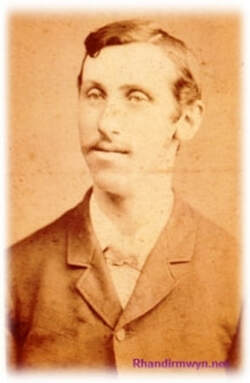
In 1883 he married Jane (background not yet known) and in 1884 they had a daughter Mary Ann. There is no doubt that life was hard and the tales of life in the New World must have appealed greatly to them. It must have been after much soul searching that they came to the biggest decision of their lives - to emigrate to America with their young daughter. Imagine the dilemma a young family heading on a 3,000 mile journey in a small ship effectively to the unknown. I doubt if they had ever seen the sea, let alone spend over 4 to 6 weeks sailing on it.
In 1888 they arrived at Ellis Island, New York and from there they moved to Pennsylvania and set up home in North Mead Street, Wilkes-Barre. This was a town in the heartland of the American coal industry and of course Thomas was well suited to work in the industry due to his experience as a lead miner at the Nantymwyn mine. He worked for the Red Ash Coal Company and Empire Colliery of Glen Alden Coal Company and retired as a foreman.
Thomas and his family remained in America for the rest of their lives eventually settling in 148 South Sherman Street, Wilkes-Barre.
In 1888 they arrived at Ellis Island, New York and from there they moved to Pennsylvania and set up home in North Mead Street, Wilkes-Barre. This was a town in the heartland of the American coal industry and of course Thomas was well suited to work in the industry due to his experience as a lead miner at the Nantymwyn mine. He worked for the Red Ash Coal Company and Empire Colliery of Glen Alden Coal Company and retired as a foreman.
Thomas and his family remained in America for the rest of their lives eventually settling in 148 South Sherman Street, Wilkes-Barre.
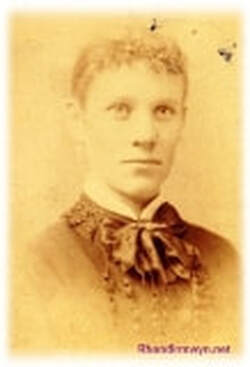
There is no record of them ever returning to Wales, even on holiday. There were however other members of the family who lived in America one being a David Harris Evans (nephew), his sister, Margaret and for a time my great grandmother Sarah lived there but it is believed that she returned to Wales.
1918 was the worst year of Thomas’ life. On 12th October his daughter died and five weeks later his wife also died, both from pneumonia.
In 1921 Thomas went on a journey with his niece Margaret to Buffalo and Niagra Falls and it was from those places he sent postcards to his family who were then living in, ’Y Graig’, Cwm Rhaeadr, Cilycwm. He sent six postcards, one to each member of the family. This is the one he sent to my father.
1918 was the worst year of Thomas’ life. On 12th October his daughter died and five weeks later his wife also died, both from pneumonia.
In 1921 Thomas went on a journey with his niece Margaret to Buffalo and Niagra Falls and it was from those places he sent postcards to his family who were then living in, ’Y Graig’, Cwm Rhaeadr, Cilycwm. He sent six postcards, one to each member of the family. This is the one he sent to my father.
On 5th May 1934 Thomas passed away and was buried along with his wife and child at the Mount Greenwood Cemetery, Trucksville, Pennsylvania.
In the local paper his obituary was recorded as follows:
‘Thomas D Evans 69 of 148 South Sherman Street, died in the general hospital on Saturday afternoon. Born in Wales Mr Evans came to this country 46 years ago. For long periods he was employed at the Red Ash Coal Company and Empire Colliery of Glen Alden Coal Company. He was a member of Fidelity Lodge of Masons, Loyal Order of Moose and the Odd Fellows. A niece, Margaret Evans and a nephew David Harris Evans of Camden, New Jersey survive’.
In the local paper his obituary was recorded as follows:
‘Thomas D Evans 69 of 148 South Sherman Street, died in the general hospital on Saturday afternoon. Born in Wales Mr Evans came to this country 46 years ago. For long periods he was employed at the Red Ash Coal Company and Empire Colliery of Glen Alden Coal Company. He was a member of Fidelity Lodge of Masons, Loyal Order of Moose and the Odd Fellows. A niece, Margaret Evans and a nephew David Harris Evans of Camden, New Jersey survive’.
His funeral was conducted at the First Welsh Presbyterian Church, Wilkes-Barre. In 1997 I went to Wilkes-Barre and visited the church. It was built by Welsh miners and is a wooden construction on the outside, but once inside you are immediately, back, inside a traditional Welsh chapel. It was wonderful. The church records up until the turn of the last century were written in Welsh.
I later visited the Mount Greenwood Cemetery, Trucksville and stood at the side of the grave of Thomas D Evans and his wife and child. It was a poignant experience
Morgan B Williams
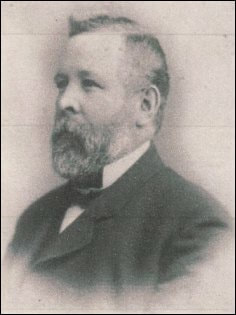
This is the story of the Williams Family of Rhandirmwyn. The main character is Morgan B. Williams who was born in Rhandirmwyn and later left these shores for pastures new.
Initially Australia but later America where he eventually settled along with his bride from Rhandirmwyn, Catherine Armstrong Jones. The fascinating story is told by William R. Williams a descendant of the Williams Family from Rhandirmwyn. He lives in Ohio, USA.
We are grateful to William (Bill) for sharing the information with us.
Diolch yn Fawr Iawn.
THE WILLIAMS FAMILY FROM RHANDIRMWYN TO AMERICA
MORGAN B. WILLIAMS, HOME TOWN BOY MAKES GOOD IN AMERICA would have made a good lead in to this article but it would not do justice to all of my Williams family, who were born, worked and lived in Llanfair-ar-bryn Parish before coming to America. They come to life for me as I attempt to share in their happiness and sorrow, success and failure, joy and pride of family, and their adventuresome spirit in leaving their beloved Wales to American Shores seeking a better life. They took their mining experience to Australia, Pennsylvania, Canada and New Mexico and plied their trades there. I am the product of a Welsh American father from Pennsylvania who came to Toledo, Ohio where he met and married a Welsh American girl making me a proud American appreciative of his Welsh Heritage.
Initially Australia but later America where he eventually settled along with his bride from Rhandirmwyn, Catherine Armstrong Jones. The fascinating story is told by William R. Williams a descendant of the Williams Family from Rhandirmwyn. He lives in Ohio, USA.
We are grateful to William (Bill) for sharing the information with us.
Diolch yn Fawr Iawn.
THE WILLIAMS FAMILY FROM RHANDIRMWYN TO AMERICA
MORGAN B. WILLIAMS, HOME TOWN BOY MAKES GOOD IN AMERICA would have made a good lead in to this article but it would not do justice to all of my Williams family, who were born, worked and lived in Llanfair-ar-bryn Parish before coming to America. They come to life for me as I attempt to share in their happiness and sorrow, success and failure, joy and pride of family, and their adventuresome spirit in leaving their beloved Wales to American Shores seeking a better life. They took their mining experience to Australia, Pennsylvania, Canada and New Mexico and plied their trades there. I am the product of a Welsh American father from Pennsylvania who came to Toledo, Ohio where he met and married a Welsh American girl making me a proud American appreciative of his Welsh Heritage.
The story begins with William Williams my namesake and Great Great Grandfather, born ca. 1801 not of the County, he ventured to Rhandirmwyn and secured a job as a lead miner in in the Township of Rhandir Abbot (Rhandirmwyn) where he wooed and married a local girl, Rachel James in the Llanfair-ar-Bryn Church by Banns on August 23,1828, by Vicar William Morgan. William signed and Rachel made her mark. Witnesses were Rich. Jones and Richard Morgan. William would rise to the position of supervising and clearing of lead ore at the Nantymwyn Mine. His children received their basic education in the Cilycwm school. As Calvinistic Methodists his two eldest children. Morgan born September 17, 1831 and Mary born October 30, born October 30, 1833 were christened in the Cilycwm Meeting House.- Another son, Daniel December 8, 1835 was christened in the Salem Calvinistic Church.
By 1841(Census) family was residing at Pentwyn in Rhandir Abbot (Rhandirmwyn) with the following children, Morgan age 9, Mary age 7, Daniel 5, Catherine age 2, and William age 4 months(my Great Grandfather) Note there may have been another child who may have died in infancy some times after 1828. The last born was John in 1843. When in his early teens Morgan joined his dad working in the mine. His father was continually in ill health and died ca. 1847 and Morgan at age 16 assumed his father's position. Brothers Daniel and William would also join him in the mines to help support their widowed mother(an annuitant and farmer) and younger siblings.
Rachel remarried a William Theophilus and they had a son, Timothy born November 7, 1853. Her second husband, predeceased her prior to 1861. Timothy would work in the mine from ages 12 to 20. In 1856 Morgan sailed to Australia in search of Gold. He returned home in 1861 and in 1862 sailed for America. William would travel to Australia in 1864 and searched for gold in Ballarat. While there he wed Elizabeth Campbell from Glasgow, Scotland. Three children were born to them while there, Rachel 1865, Thomas 1867 and William (my grandfather) 1869. They would remain in Australia for nearly 10 years, returned home and sailed to America in 1874.
Morgan would marry a local girl Catherine, daughter of Joshua and Mary Armstrong Jones of Rhandirmwyn. Timothy Theophilus would come to America in 1873 joining family in Wilkes-Barre, Pennsylvania. He briefly returned to Wales in 1878 and married Sarah, daughter of Morgan and Sarah William Williams. As to the remaining Williams, Mary would wed a Richard Davies, miner, and have 3 children, Miriam b. 1861, Elizabeth 1865 and Rachel. When Richard died family lived next door to Rachel at Pentwyn. By 1881 Miriam was living with Grandmother, Rachel Theophilus. They would come to America ca. 1882. Mary would later wed a Lewis and would remain in Wales.. She was still living in 1904 and that’s the last known of her. Catherine wed David B. Thomas, they had two sons, John R. Thomas and D. V. Thomas. She too came to America and as a widow married a David W. Evans originally from Wales. Daniel also made his way to Wilkes-Barre. Little is known about John after 1861 when he was listed as age 18 and a miners son. No details whether he emigrated and he is not listed in his mothers obituary in 1887. Some of the James may have emigrated too but have no proof of this
By 1841(Census) family was residing at Pentwyn in Rhandir Abbot (Rhandirmwyn) with the following children, Morgan age 9, Mary age 7, Daniel 5, Catherine age 2, and William age 4 months(my Great Grandfather) Note there may have been another child who may have died in infancy some times after 1828. The last born was John in 1843. When in his early teens Morgan joined his dad working in the mine. His father was continually in ill health and died ca. 1847 and Morgan at age 16 assumed his father's position. Brothers Daniel and William would also join him in the mines to help support their widowed mother(an annuitant and farmer) and younger siblings.
Rachel remarried a William Theophilus and they had a son, Timothy born November 7, 1853. Her second husband, predeceased her prior to 1861. Timothy would work in the mine from ages 12 to 20. In 1856 Morgan sailed to Australia in search of Gold. He returned home in 1861 and in 1862 sailed for America. William would travel to Australia in 1864 and searched for gold in Ballarat. While there he wed Elizabeth Campbell from Glasgow, Scotland. Three children were born to them while there, Rachel 1865, Thomas 1867 and William (my grandfather) 1869. They would remain in Australia for nearly 10 years, returned home and sailed to America in 1874.
Morgan would marry a local girl Catherine, daughter of Joshua and Mary Armstrong Jones of Rhandirmwyn. Timothy Theophilus would come to America in 1873 joining family in Wilkes-Barre, Pennsylvania. He briefly returned to Wales in 1878 and married Sarah, daughter of Morgan and Sarah William Williams. As to the remaining Williams, Mary would wed a Richard Davies, miner, and have 3 children, Miriam b. 1861, Elizabeth 1865 and Rachel. When Richard died family lived next door to Rachel at Pentwyn. By 1881 Miriam was living with Grandmother, Rachel Theophilus. They would come to America ca. 1882. Mary would later wed a Lewis and would remain in Wales.. She was still living in 1904 and that’s the last known of her. Catherine wed David B. Thomas, they had two sons, John R. Thomas and D. V. Thomas. She too came to America and as a widow married a David W. Evans originally from Wales. Daniel also made his way to Wilkes-Barre. Little is known about John after 1861 when he was listed as age 18 and a miners son. No details whether he emigrated and he is not listed in his mothers obituary in 1887. Some of the James may have emigrated too but have no proof of this
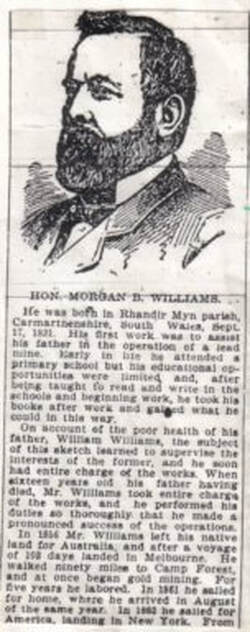
My next article will be on the Williams’ in America along with Obituaries to follow which will provide extensive information on William and Morgan( with a sketch) who rose to great success in America. Morgan started as a coal miner, became a mine owner along with interests in a Canadian graphite mine. He was active in the Welsh Presbyterian Church (contributed $5000 for its rebuilding.) He was fond of music, had a good singing voice and was a member of the Heights Glee Club as a young man .He was involved in all aspects of community life and government and would go on to serve in the Pennsylvania State Senate and the US House of Representatives. Legend has it that when relatives in Wales heard that he was running for office, one commented “that he was too fat to run”. While a Congressman he championed the bill providing that coal companies pay every two weeks and also supported the bill for the abolishment of company stores. His biography by H.C. Bradby, 1893 concludes with, “Mr. Williams has become one of the most successful and influential Welshmen in the State of Pennsylvania.”
My Great Grandfather William. J. P. Williams, was the adventurous one who took his family from Australia, to Pennsylvania to Oklahoma where he had a cattle ranch and was superintendant of a New Mexico coal mine and back to Pennsylvania. He became superintendant of The Williams Coal Co. of Pottsville (Morgan's Co) and then became supervisor of a Graphite mine in Canada (also Morgans) and back again to Wilkes-Barre, Pennsylvania. During the Great Coal Strike of 1876 he was president of the Wilkes-Barre Miners Association. He would own his own butcher shop, contracted for delivery of mine explosives and was a mining contractor. When on such a contract, sinking slopes etc and giving instructions to his men he was killed when a large piece of rock fell from the roof of the mine in 1904. Hopefully with all of these names connected to Rhandirmwyn new connections might arise.... Perhaps some of the older lifetime residents of Rhandirmyn can make these connections.
Part two will cover the Williams in America. Alun, I probably will never visit Wales but have a sense of satisfaction that these writings help bring the Williams back to Rhandirmwyn.
William R. Williams (R. for Rowland), the maiden name of my Paternal Grandmother from North Wales).
My Great Grandfather William. J. P. Williams, was the adventurous one who took his family from Australia, to Pennsylvania to Oklahoma where he had a cattle ranch and was superintendant of a New Mexico coal mine and back to Pennsylvania. He became superintendant of The Williams Coal Co. of Pottsville (Morgan's Co) and then became supervisor of a Graphite mine in Canada (also Morgans) and back again to Wilkes-Barre, Pennsylvania. During the Great Coal Strike of 1876 he was president of the Wilkes-Barre Miners Association. He would own his own butcher shop, contracted for delivery of mine explosives and was a mining contractor. When on such a contract, sinking slopes etc and giving instructions to his men he was killed when a large piece of rock fell from the roof of the mine in 1904. Hopefully with all of these names connected to Rhandirmwyn new connections might arise.... Perhaps some of the older lifetime residents of Rhandirmyn can make these connections.
Part two will cover the Williams in America. Alun, I probably will never visit Wales but have a sense of satisfaction that these writings help bring the Williams back to Rhandirmwyn.
William R. Williams (R. for Rowland), the maiden name of my Paternal Grandmother from North Wales).
THE WILLIAMS FAMILY IN AMERICA
Rachel (James) Williams Theophilus lived out the last five years of her life in Nanticoke, Pennsylvania with daughter, Catherine and her second husband, David W. Evans a mine foreman for 22 years with the Susquehanna Coal Co. Rachel died August 28, 1887. Like other family members she was interred in Hollenback Cemetery and her services held at the Welsh Presbyterian Church. Daughter, Catherine died at the age of 66 in 1903, survived by sons, John R. Thomas and councilman, D. V. Thomas. Miriam Davies, Rachel's granddaughter would marry Wm. J. Davies, have 3 children, Mary, Emily and Miriam. She would die at age 38 in 1900 in child birth. Morgan died in 1903 and William followed in 1904. Morgan’s brother Daniel was a builder and contractor in Scranton, Pennsylvania. Their half brother Timothy Theophillus was a tunnel contractor and served several terms as a Councilman at Large. He returned to Wales, married a girl from Rhandirmwyn and returned to America.
Morgan B. Williams the eldest son would rise from coal miner, to mine owner, community leader, State Senator and US Congressman. His first wife was, Catherine, daughter of Joshua and Mary Armstrong Jones of Rhandirmwyn and they had three children, Mary (Mrs. T.H. Griffiths), Rachel (Mrs. J.H. Williams of Scranton) and Benjamin F. his second wife was Mrs. Mary Edwards Davies by which he had one son, William. The attached Obituary is extensive in lauding his accomplishments.
Morgan's younger brother, Wm. J.P. Williams first three children (Thomas, Rachel and William) were born in Australia. He would return to New Mexico, Oklahoma territories several times, sons Daniel was born in Pennsylvania and Morgan in New Mexico. While in New Mexico, daughter Rachel, a schoolteacher would marry Ed. Edleman, a sheriff, remain there when family returned to Pennsylvania and died in 1902. William lost his life in a mine cave-in, in (1904). His obituary is also extensive. His widow Elizabeth Campbell Williams (Great Grandmother) died ca, 1924. Little is known about sons Morgan and Thomas who was once a member of the Mine Examining Board.
His son William P (b.1869). was my grandfather, who in his youth was a bronco buster and scout in Oklahoma Territory before family returned to Pennsylvania. He served aboard a Battleship, ‘The USS Indiana’ during the Spanish American War in gunnery and was decorated for his gallantry during the Battle of Santiago Bay. (Ironically some fifty years later I would serve aboard the Battleship, ‘USS Wisconsin’ during the Korean War.) Upon discharge he met my grandmother Ellen Rowland (b.1877) who came from North Wales at age 10. He worked for his father and carried explosives to the mines by horse drawn cart. While they were courting he actually took her with him on one of these deliveries. Needless to say, grandma was a very gritty lady.
The family moved from Wilkes-Barre to Kingston. (Regrettably a great flood destroyed all of their photographs). They had three children: William, (b.1900) Sydney b.1902 (my father) and Ellen.(b. 1916). In the early 1920s Dad came to Ohio and started a delicatessen in a large Toledo department store and served as manager. One day, William J. Hughes, a carpenter, came to his counter and they discovered their mutual Welsh heritage. Mr. Hughes family came from Penderyn and his wife.Ursula Morgan's family came from Glamorganshire in 1872. to Jackson County, Ohio. He still read his Welsh Bible. Pops was invited to church (Methodist) and Sunday dinner. It is noteworthy to mention that my grandfather had 6 daughters, two of whom were of marrying age. Father wed my mother, Anna Hughes (b.1906) in 1928 (Toledo, Ohio). My uncle Bill (b.1900, a plumber) and his wife Martha had one child, Margaret. who married, Raymond Dukinas. Uncle Bill died in1977. Aunt Ellen (b.1916) wed William Nast of Kingston, had three sons: William and twins Richard and Robert.
Aunt Ellen as the last living member of my dad's family shared my interest in a family tree and greatly assisted me in my searches, died in 2003. My mother died in 1970 (age 64) and dad in 1978. (age 76) . Grandparents, Wm. Died in 1945 at age 76. Grandmother Ellen at age 94 in 1971. Grandfather Hughes went to his rest at age 91 in 1962. However I sense that I may have helped the Williams family come full circle in the in the last two centuries and come home again to Wales (“We will keep a welcome in the hillside”) .I continue to search for more relatives in Wales and Pennsylvania. GG grandfather William reportedly died in March 1847 but I have had little luck in finding a death certificate or his place of internment. He was not born of the County and finding his place of birth could reveal his parents. Also interested in finding out what happened to Mary and John (Williams) and seek information on the James Family to add another chapter.
Regards..... William R. Williams(Bill)
Dear readers please accept my apologies for anyone I may have omitted for as the Tree grows its becomes more difficult to keep up with all of the additions.
HOWEVER FOR ANYONE MAKING A FAMILY CONNECTION IF SO INCLINED AND INTERESTED IN COMPLETING OUR FAMILY TREE ADD YOUR OWN FAMILY CONNECTIONS AND PROVIDE ME WITH YOUR INFORMATION.
Any information please leave on our guestbook page or contact us via e.mail [email protected] and we will pass on any information to William (Bill) Williams.
Morgan B. Williams the eldest son would rise from coal miner, to mine owner, community leader, State Senator and US Congressman. His first wife was, Catherine, daughter of Joshua and Mary Armstrong Jones of Rhandirmwyn and they had three children, Mary (Mrs. T.H. Griffiths), Rachel (Mrs. J.H. Williams of Scranton) and Benjamin F. his second wife was Mrs. Mary Edwards Davies by which he had one son, William. The attached Obituary is extensive in lauding his accomplishments.
Morgan's younger brother, Wm. J.P. Williams first three children (Thomas, Rachel and William) were born in Australia. He would return to New Mexico, Oklahoma territories several times, sons Daniel was born in Pennsylvania and Morgan in New Mexico. While in New Mexico, daughter Rachel, a schoolteacher would marry Ed. Edleman, a sheriff, remain there when family returned to Pennsylvania and died in 1902. William lost his life in a mine cave-in, in (1904). His obituary is also extensive. His widow Elizabeth Campbell Williams (Great Grandmother) died ca, 1924. Little is known about sons Morgan and Thomas who was once a member of the Mine Examining Board.
His son William P (b.1869). was my grandfather, who in his youth was a bronco buster and scout in Oklahoma Territory before family returned to Pennsylvania. He served aboard a Battleship, ‘The USS Indiana’ during the Spanish American War in gunnery and was decorated for his gallantry during the Battle of Santiago Bay. (Ironically some fifty years later I would serve aboard the Battleship, ‘USS Wisconsin’ during the Korean War.) Upon discharge he met my grandmother Ellen Rowland (b.1877) who came from North Wales at age 10. He worked for his father and carried explosives to the mines by horse drawn cart. While they were courting he actually took her with him on one of these deliveries. Needless to say, grandma was a very gritty lady.
The family moved from Wilkes-Barre to Kingston. (Regrettably a great flood destroyed all of their photographs). They had three children: William, (b.1900) Sydney b.1902 (my father) and Ellen.(b. 1916). In the early 1920s Dad came to Ohio and started a delicatessen in a large Toledo department store and served as manager. One day, William J. Hughes, a carpenter, came to his counter and they discovered their mutual Welsh heritage. Mr. Hughes family came from Penderyn and his wife.Ursula Morgan's family came from Glamorganshire in 1872. to Jackson County, Ohio. He still read his Welsh Bible. Pops was invited to church (Methodist) and Sunday dinner. It is noteworthy to mention that my grandfather had 6 daughters, two of whom were of marrying age. Father wed my mother, Anna Hughes (b.1906) in 1928 (Toledo, Ohio). My uncle Bill (b.1900, a plumber) and his wife Martha had one child, Margaret. who married, Raymond Dukinas. Uncle Bill died in1977. Aunt Ellen (b.1916) wed William Nast of Kingston, had three sons: William and twins Richard and Robert.
Aunt Ellen as the last living member of my dad's family shared my interest in a family tree and greatly assisted me in my searches, died in 2003. My mother died in 1970 (age 64) and dad in 1978. (age 76) . Grandparents, Wm. Died in 1945 at age 76. Grandmother Ellen at age 94 in 1971. Grandfather Hughes went to his rest at age 91 in 1962. However I sense that I may have helped the Williams family come full circle in the in the last two centuries and come home again to Wales (“We will keep a welcome in the hillside”) .I continue to search for more relatives in Wales and Pennsylvania. GG grandfather William reportedly died in March 1847 but I have had little luck in finding a death certificate or his place of internment. He was not born of the County and finding his place of birth could reveal his parents. Also interested in finding out what happened to Mary and John (Williams) and seek information on the James Family to add another chapter.
Regards..... William R. Williams(Bill)
Dear readers please accept my apologies for anyone I may have omitted for as the Tree grows its becomes more difficult to keep up with all of the additions.
HOWEVER FOR ANYONE MAKING A FAMILY CONNECTION IF SO INCLINED AND INTERESTED IN COMPLETING OUR FAMILY TREE ADD YOUR OWN FAMILY CONNECTIONS AND PROVIDE ME WITH YOUR INFORMATION.
Any information please leave on our guestbook page or contact us via e.mail [email protected] and we will pass on any information to William (Bill) Williams.
Renowden and Rees Family of Rhandirmwyn
This is a very personal story by Pat Schumacher accounting her search for her family roots. Pat lives in Florida, USA but Rhandirmwyn has become virtually her second home as much of her family history and memories are embedded in these beautiful hills. Her ancestors emigrated to America in 1882, sailing from Liverpool. The journey started in tragic circumstances as one of their children was burnt to death in Liverpool shortly before embarking on the arduous journey across the Atlantic.
Thank you Pat for sharing the information and story.
I must also add a note of gratitude to the Renowden family as my late mother moved to Rhandirmwyn in 1927 at the age of 14 from the Swansea valley to work for William and Sarah Renowden at the Royal Oak public house. I have no doubt that it was there she met my father who had been born in the village. The rest is history.
Alun Jones
Thank you Pat for sharing the information and story.
I must also add a note of gratitude to the Renowden family as my late mother moved to Rhandirmwyn in 1927 at the age of 14 from the Swansea valley to work for William and Sarah Renowden at the Royal Oak public house. I have no doubt that it was there she met my father who had been born in the village. The rest is history.
Alun Jones
Renowden and Rees: An Introductions
My research into the Welsh branch of the family brought many surprises: for one, the ancestors were as much Cornish as Welsh in heritage. The Cornish people moved back and forth, by sea, between the very southwestern-most part of England to Wales for work in the mines. Their mining skills were highly sought after in times when Wales needed more skilled workers. Marriage was common among the Welsh and Cornish families and, as it turns out, we are as much Cornish as Welsh.
That said, the connection between the Cornish people and the Welsh people is stronger than geography. They are both of Celtic origin, and both were pushed back when the Normans invaded England. Their native languages are similar in origin.
Rhandirmwyn, the birthplace of my grandfather, Rees Reese, is a small village nestled in the Cambrian Mountains. Lead mining has been the major employer in the village for centuries, some say back to Roman times (400 A.D.). Initially, it was part of a fiefdom owned by the British Lord Cawdor. The countryside has an ancient history, some say going back to Merlin who, it is said, lived in a cave in the mountains nearby.
The Reese name is of Welsh origin, originally spelled Rhys, then Rees, then Reese. In feudal times, there were famous warriors named Rhys. Tracing family from the ancient times to the present, with a very common Welsh name, proved impossible. I was only able to find definite family links going back to the late 1700’s. Using the same first and last names is a common practice, hence my grandfather’s name, Rees David Reese. His first name uses the older form, while the surname changed permanently to add an “e” to the end, when the family immigrated to America.
Renowdens were an interesting study. They came to Wales from Cornwall and go back much further, to the early 1700’s in England. The have migrated to Australia as well as America. There are fewer Renowdens left in England now, and none in Wales that I found.
That said, the connection between the Cornish people and the Welsh people is stronger than geography. They are both of Celtic origin, and both were pushed back when the Normans invaded England. Their native languages are similar in origin.
Rhandirmwyn, the birthplace of my grandfather, Rees Reese, is a small village nestled in the Cambrian Mountains. Lead mining has been the major employer in the village for centuries, some say back to Roman times (400 A.D.). Initially, it was part of a fiefdom owned by the British Lord Cawdor. The countryside has an ancient history, some say going back to Merlin who, it is said, lived in a cave in the mountains nearby.
The Reese name is of Welsh origin, originally spelled Rhys, then Rees, then Reese. In feudal times, there were famous warriors named Rhys. Tracing family from the ancient times to the present, with a very common Welsh name, proved impossible. I was only able to find definite family links going back to the late 1700’s. Using the same first and last names is a common practice, hence my grandfather’s name, Rees David Reese. His first name uses the older form, while the surname changed permanently to add an “e” to the end, when the family immigrated to America.
Renowdens were an interesting study. They came to Wales from Cornwall and go back much further, to the early 1700’s in England. The have migrated to Australia as well as America. There are fewer Renowdens left in England now, and none in Wales that I found.
NOTES ON RESEARCH AND TRAVEL TO WALES AND CORNWALL
I visited Wales three times: the first in 1974, with husband Kay Schumacher. I had in hand a very old picture from my grandfather, of a building that I believed was in Wales. We stayed in a bed and breakfast in Llandovery, Wales, the nearest large town to the village of Rhandirmwyn where my grandfather was born. That evening in the lodge, I passed the picture around to other guests. One man, a salesman, immediately recognized the building as the pub in the middle of Rhandirmwyn, and he said we would have no trouble finding it the next morning.
Rhandirmwyn is about seven miles from Llandovery but the road climbs into the mountains; it is winding and narrow, with hedgerows along the edges. Meeting cars (while on the left side of the road) is formidable. Just as the salesman told us, the pub dominates the village. The Royal Oak Inn is a solid stone building, larger than most other buildings, at the top of a hill and right off the road that winds through town.
We stopped and visited with the owners. They informed us that the last Renowdens to own the pub had left it in 1954, twenty years earlier. I visited with a few people in town and showed the picture around. There are four men in the picture, lounging on the grass in front of the inn. Three were immediately identified but the fourth, the one I determined might be the relative, went unnamed. Last, we visited the home of a Mrs. James (her maiden name was Reese) and she knew the fourth man immediately—it was Johhny Renowden, son of the John Renowden who built the pub in 1846. Johnny hanged himself, she said, in the pub. I’m sure all the others knew that, too, but didn't want to tell the American about the family tragedy.
The second trip was in 2008, thirty-four years later, with granddaughter Seina. All the people I had visited with on the first trip had passed away. We visited the pub and its new owners, Leigh and Claire Alexander, who have owned it for the last twenty-two years. They built an addition as living quarters for their family. They showed us the rooms upstairs which are available for hire. They are small, modest rooms, with bathrooms down the hall. They knew little about the Renowden history and I shared what I knew with them, including the story of Johnny Renowden hanging himself upstairs. They responded with stories of ghosts in the building and specific incidences when a “ghost barman” was taking orders that were never filled.
We visited #4 Pannau Street, the center unit of an eight-unit stone row house, and the birthplace of Grandpa Reese. It had just been purchased by Christine Reilly who was moving in, and offered to let us in to see the interior. Kitchens and a bathroom have been added on to the back of the building; in Grandpa’s day the cooking was done over the fireplace, and the outhouse down the way served all eight families.
The third trip to Wales was in 2012, with brother Bob. The internet has become an important tool in the meantime, and I connected with Alun Jones who created a website for the village of Rhandirmwyn. We met he and his wife, Carol, and were led on a close and personal tour of the village, the closed down mine where our great-grandfather labored, and the surrounding countryside. It was a rich and valuable experience for us both. Alun grew up in Rhandirmwyn and was able to answer many, many questions. He helped us research the Reese family back further, and found a valuable newspaper article on Elizabeth Cowling, a Cornish great-great-grandmother who lived in the village and married a Reese.
From there, we drove to the National Library of Wales in Aberystwyth on the west coast of Wales. We spent two days researching family and were able to discover another couple of generations back. We looked at Bishop’s handwritten copies of church registers that went back to the 1500’s. It is a an amazing resource and I could spend weeks there.
Rick Parsons has done years of genealogical research on the Renowden Family which I also found on the internet. We connected by e-mail and he very kindly shared his extensive work with me. His wife, Mary Parsons, is my third cousin; it is her family who produced the Welsh Bishop. We met for dinner one evening in Bristol.
Last, Bob and I drove to Cornwall and were amazed at the rugged beauty. The tops of the hills are moors which are windswept and grassy, but the terrain going down to the sea is rugged and steep. We visited St. Ives, birthplace of John Renowden, and also visited St. Agnes, the birthplace of Thomas Cowling. Both are villages hugging the shoreline, beneath the rocky hills above them. They are beautiful beyond description.
The interior town of Truro, Cornwall, has a genealogy center which we visited. The volunteers there were very helpful and solved some mysteries I had about lineage, and pushed us back another few generations with the Renowden family.
And now, to introduce my Grandfather Reese, my mother’s father, we journey to Wales, and to Cornwall in Southwest England.
Rhandirmwyn is about seven miles from Llandovery but the road climbs into the mountains; it is winding and narrow, with hedgerows along the edges. Meeting cars (while on the left side of the road) is formidable. Just as the salesman told us, the pub dominates the village. The Royal Oak Inn is a solid stone building, larger than most other buildings, at the top of a hill and right off the road that winds through town.
We stopped and visited with the owners. They informed us that the last Renowdens to own the pub had left it in 1954, twenty years earlier. I visited with a few people in town and showed the picture around. There are four men in the picture, lounging on the grass in front of the inn. Three were immediately identified but the fourth, the one I determined might be the relative, went unnamed. Last, we visited the home of a Mrs. James (her maiden name was Reese) and she knew the fourth man immediately—it was Johhny Renowden, son of the John Renowden who built the pub in 1846. Johnny hanged himself, she said, in the pub. I’m sure all the others knew that, too, but didn't want to tell the American about the family tragedy.
The second trip was in 2008, thirty-four years later, with granddaughter Seina. All the people I had visited with on the first trip had passed away. We visited the pub and its new owners, Leigh and Claire Alexander, who have owned it for the last twenty-two years. They built an addition as living quarters for their family. They showed us the rooms upstairs which are available for hire. They are small, modest rooms, with bathrooms down the hall. They knew little about the Renowden history and I shared what I knew with them, including the story of Johnny Renowden hanging himself upstairs. They responded with stories of ghosts in the building and specific incidences when a “ghost barman” was taking orders that were never filled.
We visited #4 Pannau Street, the center unit of an eight-unit stone row house, and the birthplace of Grandpa Reese. It had just been purchased by Christine Reilly who was moving in, and offered to let us in to see the interior. Kitchens and a bathroom have been added on to the back of the building; in Grandpa’s day the cooking was done over the fireplace, and the outhouse down the way served all eight families.
The third trip to Wales was in 2012, with brother Bob. The internet has become an important tool in the meantime, and I connected with Alun Jones who created a website for the village of Rhandirmwyn. We met he and his wife, Carol, and were led on a close and personal tour of the village, the closed down mine where our great-grandfather labored, and the surrounding countryside. It was a rich and valuable experience for us both. Alun grew up in Rhandirmwyn and was able to answer many, many questions. He helped us research the Reese family back further, and found a valuable newspaper article on Elizabeth Cowling, a Cornish great-great-grandmother who lived in the village and married a Reese.
From there, we drove to the National Library of Wales in Aberystwyth on the west coast of Wales. We spent two days researching family and were able to discover another couple of generations back. We looked at Bishop’s handwritten copies of church registers that went back to the 1500’s. It is a an amazing resource and I could spend weeks there.
Rick Parsons has done years of genealogical research on the Renowden Family which I also found on the internet. We connected by e-mail and he very kindly shared his extensive work with me. His wife, Mary Parsons, is my third cousin; it is her family who produced the Welsh Bishop. We met for dinner one evening in Bristol.
Last, Bob and I drove to Cornwall and were amazed at the rugged beauty. The tops of the hills are moors which are windswept and grassy, but the terrain going down to the sea is rugged and steep. We visited St. Ives, birthplace of John Renowden, and also visited St. Agnes, the birthplace of Thomas Cowling. Both are villages hugging the shoreline, beneath the rocky hills above them. They are beautiful beyond description.
The interior town of Truro, Cornwall, has a genealogy center which we visited. The volunteers there were very helpful and solved some mysteries I had about lineage, and pushed us back another few generations with the Renowden family.
And now, to introduce my Grandfather Reese, my mother’s father, we journey to Wales, and to Cornwall in Southwest England.
JOHN RENOWDEN and the ROYAL OAK INN Born 1815 - 7 July 1890
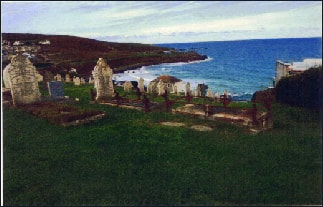
Maternal Great-great grandfather, father of Amelia Renowden Reese, my great-grandmother
The earliest members of the Renowden family came from Cornwall, the southwestern-most part of England, so at least half of the "Welsh" family heritage is actually English. Since Cornwall and Wales were both inhabited by descendants of the ancient Bretons (now called “Celtic”), the original modern settlers in the British Isles, it is safe to say they are all from the same or similar stock. Their native language, both Celtic dialogs, are similar.
John Renowden was born in a tiny sea coast town of St. Ives, Cornwall, in the southwest corner of England, in the year 1815.
The earliest members of the Renowden family came from Cornwall, the southwestern-most part of England, so at least half of the "Welsh" family heritage is actually English. Since Cornwall and Wales were both inhabited by descendants of the ancient Bretons (now called “Celtic”), the original modern settlers in the British Isles, it is safe to say they are all from the same or similar stock. Their native language, both Celtic dialogs, are similar.
John Renowden was born in a tiny sea coast town of St. Ives, Cornwall, in the southwest corner of England, in the year 1815.
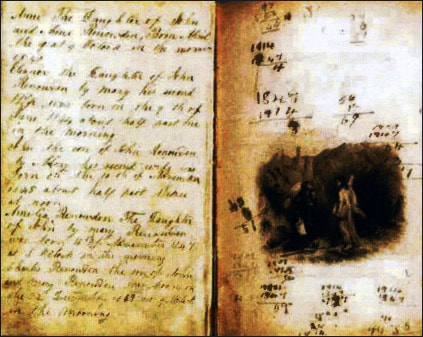
His parents were John Renowden of Zennor, Cornwall (1792-1835) and Bathsheba Allen (1785-1868)
As a young man, John migrated to Wales, to work in the Nantymwyn mine in Rhandirmwyn, county of Carmarthen, Wales. He most likely traveled by ship, probably in the late 1830's. Both Cornwall and central Wales were mining areas but the Cornish people had the reputation for more knowledge and experience and were highly sought after as employees when times were good. In 1836, the lease ownership of the mine was transferred to a Cornish family named Williams and it is probable that many Cornish miners migrated to Wales then.
Sometime between 1846 and 1851, John established a public house called the Royal Oak Inn. It had a few rooms to let upstairs, and downstairs the public house served food and drinks. The stone building was heated by two large fireplaces, one at each end of the main room. The Inn was in the Renowden family for over 100 years.
John Renowden married three times, each time to a local area woman. His first wife, Anne Davies, died in childbirth at the age of 21, bearing their third child. Only one child lived, Anne (born 1840), and she apparently was raised by another family after her mother’s death (in 1842).
His second wife (my great-great grandmother) was Mary Williams (1816-1882) from Llansawel, a small town about 12 miles from Rhandirmwyn. Her father was Charles Williams. John and Mary were married October 4, 1843, and had seven children, five boys and two girls. My great-grandmother, Amelia Renowden (1847-1884) was the third-born and the only surviving girl. John Renowden recorded all the children’s births in the front pages of a copy of Pilgrim’s Progress. I received this book after my trip to Wales in 2012, as the last surviving Renowden relative in the area had died without descendants.
As a young man, John migrated to Wales, to work in the Nantymwyn mine in Rhandirmwyn, county of Carmarthen, Wales. He most likely traveled by ship, probably in the late 1830's. Both Cornwall and central Wales were mining areas but the Cornish people had the reputation for more knowledge and experience and were highly sought after as employees when times were good. In 1836, the lease ownership of the mine was transferred to a Cornish family named Williams and it is probable that many Cornish miners migrated to Wales then.
Sometime between 1846 and 1851, John established a public house called the Royal Oak Inn. It had a few rooms to let upstairs, and downstairs the public house served food and drinks. The stone building was heated by two large fireplaces, one at each end of the main room. The Inn was in the Renowden family for over 100 years.
John Renowden married three times, each time to a local area woman. His first wife, Anne Davies, died in childbirth at the age of 21, bearing their third child. Only one child lived, Anne (born 1840), and she apparently was raised by another family after her mother’s death (in 1842).
His second wife (my great-great grandmother) was Mary Williams (1816-1882) from Llansawel, a small town about 12 miles from Rhandirmwyn. Her father was Charles Williams. John and Mary were married October 4, 1843, and had seven children, five boys and two girls. My great-grandmother, Amelia Renowden (1847-1884) was the third-born and the only surviving girl. John Renowden recorded all the children’s births in the front pages of a copy of Pilgrim’s Progress. I received this book after my trip to Wales in 2012, as the last surviving Renowden relative in the area had died without descendants.
THE ROYAL OAK INN, about 1890.
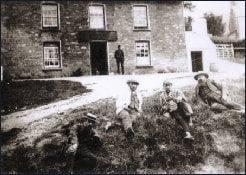
Left to right: David Vincent Lewis (Schoolmaster), Johnny Renowden (Owner of the Royal Oak Inn and eldest son of John Renowden, brother of Amelia), David Owen (Schoolmaster, Postmaster and historian of the Rhandirmwyn area), and David Thomas (neighbor on Pannau Street and owner of the Miner’s Arms pub).
Royal Oak Inn, 2008. Seina Johndro (Four times great-granddaughter of John Renowden who built the inn) and Pat Schumacher (Two times great-granddaughter)
AMELIA RENOWDEN 16 Nov 1847 - 1 Dec 1884
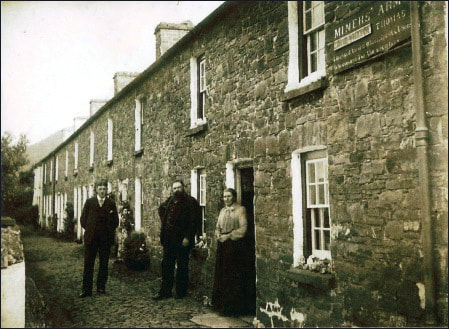 Miners Arms, Pannau Street
Miners Arms, Pannau Street
My Maternal Great-grandmother and mother of my grandfather, Rees Reese. daughter of John Renowden, founder of the Royal Oak Inn.
The short story of Amelia’s life, pieced together with census data, birth and death records and ship manifests, tells a story of a young woman who bore nine children and lost four of them within a two-year period. She died two years after immigrating to America, at age 37, most likely as a result of the birth of her ninth child, who also died.
Amelia was my great-grandmother and was born November 16, 1847, in Rhandirmwyn, Carmarthenshire County, Wales. She was the second of six children, and her parents, John and Mary Renowden, were owners of a new pub (the Royal Oak Inn built about 1846), located in the center of the mining village of Rhandirmwyn. She was the only surviving girl child. Most likely, Amelia had no schooling at all and, in her teen years, worked as a bar maid.
At age 22 she married James David Reese, the son of local farmers just south of town. They had six children in nine years, and lived in a tiny stone row house on Pannau Street, #4. Eight families lived in the row of attached two-room cottages. The housing was provided for the miners to rent, and many of the families had origins in Cornwall.
Winters in the low mountains around Rhandirmwyn could be quite cold, with a raw wind whipping up between the high hills. The house had two windows which had to be stuffed around the edges with paper or cloth in the winters and hung with curtains to keep out the cold. The only heat was from the fireplace. James worked in the nearby mine and was sometimes paid with lumps of coal. The family buried coal in the ground to store it until needed. (Christine Reilly, who bought the stone row house in 2008, found a large lump of coal buried in the garden).
Life in the years from Amelia’s birth in1847, to the time they left for America in 1882, was harsh and hungry. The family had no wealth to own a horse, so any transportation was on foot, or had to be purchased. In the backyard of the row house, families kept gardens and probably a coop of chickens, perhaps a goat for milk. The garden was essential to provide food; there were no grocery stores
Below, Pannau Street about 1890 showing the Thomas family, neighbors of James and Amelia Reese. The Thomas’s ran the Miners’ Arms, a pub, from their two-room home. It was located on the end of the row, next to the path the miners used when they walked home at the end of the day. You can see the sign next to the upstairs window.
James and Amelia lived in Unit #4, in the center of the row. The downstairs was one great room, with a fireplace for cooking and providing warmth to the entire home. All family activities, except sleeping, occurred in this room. Upstairs was one bedroom, where six children and two adults slept. There was probably only one bed. The rooms were small, perhaps 9 by 10 feet. There was no running water and the toilet was outside.
Children were born at home, perhaps with a local woman attending. Amelia gave birth to David in 1871 (she was 24), John in 1872, Rees (my grandfather) in 1874, Daniel in 1875, Mary in 1876, Isaac in 1879, and Elizabeth in 1880.
Amelia had two more babies in America, Bessie, born in 1883, and Charles, still born, in 1984. Also in 1883, a diphtheria epidemic took her second son, John, and baby Isaac.
I can find no record of Amelia after 1884. My assumption is that she died in childbirth, along with Charles. Before she died, Amelia lost four of her nine children. She was 37 years old.
The short story of Amelia’s life, pieced together with census data, birth and death records and ship manifests, tells a story of a young woman who bore nine children and lost four of them within a two-year period. She died two years after immigrating to America, at age 37, most likely as a result of the birth of her ninth child, who also died.
Amelia was my great-grandmother and was born November 16, 1847, in Rhandirmwyn, Carmarthenshire County, Wales. She was the second of six children, and her parents, John and Mary Renowden, were owners of a new pub (the Royal Oak Inn built about 1846), located in the center of the mining village of Rhandirmwyn. She was the only surviving girl child. Most likely, Amelia had no schooling at all and, in her teen years, worked as a bar maid.
At age 22 she married James David Reese, the son of local farmers just south of town. They had six children in nine years, and lived in a tiny stone row house on Pannau Street, #4. Eight families lived in the row of attached two-room cottages. The housing was provided for the miners to rent, and many of the families had origins in Cornwall.
Winters in the low mountains around Rhandirmwyn could be quite cold, with a raw wind whipping up between the high hills. The house had two windows which had to be stuffed around the edges with paper or cloth in the winters and hung with curtains to keep out the cold. The only heat was from the fireplace. James worked in the nearby mine and was sometimes paid with lumps of coal. The family buried coal in the ground to store it until needed. (Christine Reilly, who bought the stone row house in 2008, found a large lump of coal buried in the garden).
Life in the years from Amelia’s birth in1847, to the time they left for America in 1882, was harsh and hungry. The family had no wealth to own a horse, so any transportation was on foot, or had to be purchased. In the backyard of the row house, families kept gardens and probably a coop of chickens, perhaps a goat for milk. The garden was essential to provide food; there were no grocery stores
Below, Pannau Street about 1890 showing the Thomas family, neighbors of James and Amelia Reese. The Thomas’s ran the Miners’ Arms, a pub, from their two-room home. It was located on the end of the row, next to the path the miners used when they walked home at the end of the day. You can see the sign next to the upstairs window.
James and Amelia lived in Unit #4, in the center of the row. The downstairs was one great room, with a fireplace for cooking and providing warmth to the entire home. All family activities, except sleeping, occurred in this room. Upstairs was one bedroom, where six children and two adults slept. There was probably only one bed. The rooms were small, perhaps 9 by 10 feet. There was no running water and the toilet was outside.
Children were born at home, perhaps with a local woman attending. Amelia gave birth to David in 1871 (she was 24), John in 1872, Rees (my grandfather) in 1874, Daniel in 1875, Mary in 1876, Isaac in 1879, and Elizabeth in 1880.
Amelia had two more babies in America, Bessie, born in 1883, and Charles, still born, in 1984. Also in 1883, a diphtheria epidemic took her second son, John, and baby Isaac.
I can find no record of Amelia after 1884. My assumption is that she died in childbirth, along with Charles. Before she died, Amelia lost four of her nine children. She was 37 years old.
Now on to Amelia’s husband, James David Reese and his story……
DAVID REES & ELIZABETH COWLING
(1812 - 1879) (1810 - 1877)
Maternal Great-great grandparents, father of James David Reese
David Rees was born in the village of Rhandirmwyn, in a house named Pencarreg, along the main road, just up from the Royal Oak Inn. His parents were John and Isabel Rees.
Elizabeth Cowling Rees’ family was from Cornwall. Her father, Thomas Cowling, was born in St. Agnes, Cornwall, England in 1768. The Cornish were known for their mining skills and were recruited to work in the Carmarthenshire mines when times were good. He brought along his wife, Anna James (1762-1853). Anna was later called Hannah. Elizabeth was their only child, born on Crincae farm, when Hannah was nearly 50 years old. Hannah James Cowling lived with Elizabeth, her only child, all her life, and lived to be 91 years old, an astonishing age for that era.
David and Elizabeth were married November 29,1839, and they farmed her parents’ farm (Crincae) the rest of their lives. David worked in the Nantymwyn Mine as well as farming his in-laws’ farm, and lived to the age of 67. He and Elizabeth had nine chidren, James (my great-grandfather) was the 4th. Children died frequently, from accidents and contagious illnesses; they lost several of their children. One particularly sad episode involved William (two years younger than James) who took a horse and cart to a neighboring town to obtain lime to fertilize the farm fields. On the way home, the full cart overturned, pinning William underneath. He died of the injuries--he was fourteen years old.
It is said the Elizabeth never got over the deaths of her children and as reported in the local paper, “It is common knowledge that depression caused the termination of her life”. She was 66 years old.
I am attaching a report written by current local resident, Handel Jones, who found this information while searching for his own family (unrelated). It was kindly passed on to me by Alun Jones, his friend, who assisted my brother and I greatly on our trip to Wales in 2012. From this, one can obtain an understanding of the sadness of the times, and the difficulties of life in the mid to late 1800’s in Wales.
David Rees was born in the village of Rhandirmwyn, in a house named Pencarreg, along the main road, just up from the Royal Oak Inn. His parents were John and Isabel Rees.
Elizabeth Cowling Rees’ family was from Cornwall. Her father, Thomas Cowling, was born in St. Agnes, Cornwall, England in 1768. The Cornish were known for their mining skills and were recruited to work in the Carmarthenshire mines when times were good. He brought along his wife, Anna James (1762-1853). Anna was later called Hannah. Elizabeth was their only child, born on Crincae farm, when Hannah was nearly 50 years old. Hannah James Cowling lived with Elizabeth, her only child, all her life, and lived to be 91 years old, an astonishing age for that era.
David and Elizabeth were married November 29,1839, and they farmed her parents’ farm (Crincae) the rest of their lives. David worked in the Nantymwyn Mine as well as farming his in-laws’ farm, and lived to the age of 67. He and Elizabeth had nine chidren, James (my great-grandfather) was the 4th. Children died frequently, from accidents and contagious illnesses; they lost several of their children. One particularly sad episode involved William (two years younger than James) who took a horse and cart to a neighboring town to obtain lime to fertilize the farm fields. On the way home, the full cart overturned, pinning William underneath. He died of the injuries--he was fourteen years old.
It is said the Elizabeth never got over the deaths of her children and as reported in the local paper, “It is common knowledge that depression caused the termination of her life”. She was 66 years old.
I am attaching a report written by current local resident, Handel Jones, who found this information while searching for his own family (unrelated). It was kindly passed on to me by Alun Jones, his friend, who assisted my brother and I greatly on our trip to Wales in 2012. From this, one can obtain an understanding of the sadness of the times, and the difficulties of life in the mid to late 1800’s in Wales.
JAMES DAVID REESE 2 Aug 1845 - 8 Oct 1918
Maternal Great-grandfather and husband of Amelia Renowden
James David Reese was born on a farm named Crincae, just outside of Rhandirmwyn, Wales on 2 August 1845. He was the fourth of nine children.
I could learn little about his early life except that he was raised on a farm and went to work very early in the lead mine that ran for miles and miles underneath the village of Rhandirmwyn. His mother’s families were miners and his father worked in both the mine and at farming.
Mining was the main source of income for the village. James worked in the nearby lead mine which provided employment for up to 400 people in the best years. But the mine prosperity fluctuated and there were bad years when many were laid off. When the mine needed more men, they hired experienced miners from Cornwall, England, who were also of Celtic heritage. The Cornish moved to Rhandirmwyn, settled in, and many intermarried with local women, including both Amelia and James’ parents.
James grandparents were from Cornwall, and his mother was Cornish. Amelia’s father was born in Cornwall but her mother, Mary, was from a local family. When the mine had a downturn, prejudice against the “outsiders” (the Cornish) grew. All Cornish men were told to leave, but John Renowden was allowed to remain because he had married a local girl and owned a local business, the pub, that was important to the community. James’ parents also remained more easily, most likely because his mother did not displace a mining job.
The Nantymwyn mine was underground, and work was unbearably difficult and dangerous. There were many tragic accidents and many miners died at a young age of lung disease and lead toxicity . James toiled underneath the ground most days and when work was slack, was probably laid off. The town sat on top of an underground lead mine which, it is told, was first mined by the Romans in the 4th century. The mine runs for miles under the mountainous community and provided a livelihood to most of the area residents for centuries.
The toxic aspect of lead was not known, but in 1974 when I visited Rhandirmwyn, I asked the oldest person I could find in town, a lovely lady named Miss Harris, in her 80’s, to describe the oldest people she could remember from her childhood. She responded that there were no old people in town when she was young; they all died at a young age of lead poisoning. The hard and uncertain conditions of working as a miner most likely prompted their move to America in 1882 .
Two years after James’ mother died, the family prepared to leave for America.
James left first, to look for work and find a place for his family to live. A few years later, in 1882, Amelia and six children (David, John, Rees, Daniel, Mary and Isaac) along with her sister-in-law and three more children, boarded the Ship Wyoming in Liverpool and sailed to America.
The night before sailing, in a Liverpool boarding house, two-year old Elizabeth, the seventh child of Amelia and James, climbed the stairs to bed with a candle stick in her hand. Her night gown caught fire and she burned to death. The family left the next day for America, with passage already booked and nothing to be done.
Amelia had two more babies in America, Bessie, born in 1883, and Charles, still born, in 1984, and the probable cause of her death. Also in 1883, a diphtheria epidemic took her second son, John, and baby Isaac.
James lived a long time after Amelia died and never married again. He worked in Pennsylvania as a miner, a laborer, and sometimes as a nurse or orderly in a hospital. His eldest son, David, returned to Wales when he was 21 and lived there about 10 years, married a Welsh girl named Catherine, and had two children there. He returned to America in 1899. James lives in Wilkes-Barre until his children were grown and then lived for awhile with Reese and his family, in Minnesota. He returned to Pennsylvania and died in 1918, at the age of 73
I could learn little about his early life except that he was raised on a farm and went to work very early in the lead mine that ran for miles and miles underneath the village of Rhandirmwyn. His mother’s families were miners and his father worked in both the mine and at farming.
Mining was the main source of income for the village. James worked in the nearby lead mine which provided employment for up to 400 people in the best years. But the mine prosperity fluctuated and there were bad years when many were laid off. When the mine needed more men, they hired experienced miners from Cornwall, England, who were also of Celtic heritage. The Cornish moved to Rhandirmwyn, settled in, and many intermarried with local women, including both Amelia and James’ parents.
James grandparents were from Cornwall, and his mother was Cornish. Amelia’s father was born in Cornwall but her mother, Mary, was from a local family. When the mine had a downturn, prejudice against the “outsiders” (the Cornish) grew. All Cornish men were told to leave, but John Renowden was allowed to remain because he had married a local girl and owned a local business, the pub, that was important to the community. James’ parents also remained more easily, most likely because his mother did not displace a mining job.
The Nantymwyn mine was underground, and work was unbearably difficult and dangerous. There were many tragic accidents and many miners died at a young age of lung disease and lead toxicity . James toiled underneath the ground most days and when work was slack, was probably laid off. The town sat on top of an underground lead mine which, it is told, was first mined by the Romans in the 4th century. The mine runs for miles under the mountainous community and provided a livelihood to most of the area residents for centuries.
The toxic aspect of lead was not known, but in 1974 when I visited Rhandirmwyn, I asked the oldest person I could find in town, a lovely lady named Miss Harris, in her 80’s, to describe the oldest people she could remember from her childhood. She responded that there were no old people in town when she was young; they all died at a young age of lead poisoning. The hard and uncertain conditions of working as a miner most likely prompted their move to America in 1882 .
Two years after James’ mother died, the family prepared to leave for America.
James left first, to look for work and find a place for his family to live. A few years later, in 1882, Amelia and six children (David, John, Rees, Daniel, Mary and Isaac) along with her sister-in-law and three more children, boarded the Ship Wyoming in Liverpool and sailed to America.
The night before sailing, in a Liverpool boarding house, two-year old Elizabeth, the seventh child of Amelia and James, climbed the stairs to bed with a candle stick in her hand. Her night gown caught fire and she burned to death. The family left the next day for America, with passage already booked and nothing to be done.
Amelia had two more babies in America, Bessie, born in 1883, and Charles, still born, in 1984, and the probable cause of her death. Also in 1883, a diphtheria epidemic took her second son, John, and baby Isaac.
James lived a long time after Amelia died and never married again. He worked in Pennsylvania as a miner, a laborer, and sometimes as a nurse or orderly in a hospital. His eldest son, David, returned to Wales when he was 21 and lived there about 10 years, married a Welsh girl named Catherine, and had two children there. He returned to America in 1899. James lives in Wilkes-Barre until his children were grown and then lived for awhile with Reese and his family, in Minnesota. He returned to Pennsylvania and died in 1918, at the age of 73
REES DAVID REESE
30 May 1874 - 22 September 1955
Maternal Grandfather
Rees Reese was born to Amelia Renowden Rees and James David Rees in the village of Rhandirmwyn, County of Carmarthenshire, Wales, in 1874. He was the third child, and the third son, born to the family. He eventually had eight siblings, although four died in childhood. The four remaining were David (born 1871), Daniel (born 1875), Mary (born 1876) and Bessie (born 1883 in America).
The family lived at #4, Pannau Street, a stone row house of eight homes, built especially for the miner’s families. The house had two rooms, one downstairs and one upstairs and was heated in the winter by a fireplace in the living room, using coal. The entire family (nine people at its most) slept together in the single upstairs bedroom.
I don’t know if Rees attended school in Wales although a school had been formed in the village by that time. None of his family appears in the school rosters. I do know that he had eloquent handwriting and could read newspapers at the end of his life.
The family moved to America in 1882, when Rees was eight years old. At that time, the family consisted of seven children, Rees being right in the middle by age. Tragically, the youngest child, Elizabeth who was two years old, burned to death when her nightgown caught fire from a candle, the night before the family sailed from Liverpool.
In America, the family settled in Wilkes-Barre, Pennsylvania, where mining skills were useful and jobs could be found. Within a year, a diphtheria epidemic took two more children: John, age eleven and the next oldest boy to Rees, and Isaac, now four years old, died in 1883. Also in 1883, a new baby girl, Bessie, joined the family, and in 1884 another baby was on the way. Amelia and the baby, Charles, both died in 1884, most likely a result of a difficult childbirth.
At age ten, Rees was left without a mother and grieving the loss of three siblings. In addition, there was a one-year-old baby sister with no mother. It’s not hard to imagine how difficult those years were for this immigrant family.
The oldest child, David, was 13, but by the time he was 18, he had returned to Wales for about ten years where he married and had children. There is a story that James, his father, also returned to Wales about that time but I can’t corroborate it. If so, he returned within a year as he is “missing” from directories during the year 1890. If true, that would mean Rees was the lone head of the family at age 15 or 16 for about a year, with a seven-year old sister, and responsibility for two other siblings.
The family lived at #4, Pannau Street, a stone row house of eight homes, built especially for the miner’s families. The house had two rooms, one downstairs and one upstairs and was heated in the winter by a fireplace in the living room, using coal. The entire family (nine people at its most) slept together in the single upstairs bedroom.
I don’t know if Rees attended school in Wales although a school had been formed in the village by that time. None of his family appears in the school rosters. I do know that he had eloquent handwriting and could read newspapers at the end of his life.
The family moved to America in 1882, when Rees was eight years old. At that time, the family consisted of seven children, Rees being right in the middle by age. Tragically, the youngest child, Elizabeth who was two years old, burned to death when her nightgown caught fire from a candle, the night before the family sailed from Liverpool.
In America, the family settled in Wilkes-Barre, Pennsylvania, where mining skills were useful and jobs could be found. Within a year, a diphtheria epidemic took two more children: John, age eleven and the next oldest boy to Rees, and Isaac, now four years old, died in 1883. Also in 1883, a new baby girl, Bessie, joined the family, and in 1884 another baby was on the way. Amelia and the baby, Charles, both died in 1884, most likely a result of a difficult childbirth.
At age ten, Rees was left without a mother and grieving the loss of three siblings. In addition, there was a one-year-old baby sister with no mother. It’s not hard to imagine how difficult those years were for this immigrant family.
The oldest child, David, was 13, but by the time he was 18, he had returned to Wales for about ten years where he married and had children. There is a story that James, his father, also returned to Wales about that time but I can’t corroborate it. If so, he returned within a year as he is “missing” from directories during the year 1890. If true, that would mean Rees was the lone head of the family at age 15 or 16 for about a year, with a seven-year old sister, and responsibility for two other siblings.
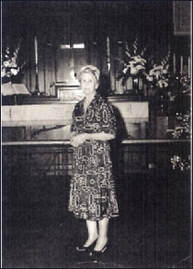
In my grandfather’s eyes, the true hero of the orphaned family was Mary, or “May” as my grandfather lovingly called her. May took over the nurturing of the family after her mother died. She was eight years old when Amelia died and baby Bessie was only one year old. May, being the only other girl, was most probably her “mother” from then on. She never worked outside the home, but always kept house for her father and brothers. Later when Daniel married, his wife died and he was left with three small children. May moved to Detroit and helped him raise those children, too. She never married and never had her own family
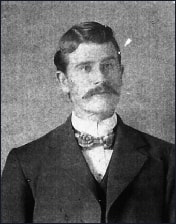
Rees started working by age 18, first as a driver, then a miner for the next 4-6 years, and at age 24, he began working as a surveyor. His father worked all his life as a laborer or a miner, but Rees managed to become a white-collar worker eventually, and left the work as miner behind him.
On June 18, 1902, Rees married Catherine Kemery Moyer in West Pittston, Pennsylvania. I don’t know how they met and what their courtship was like, but all the pictures of Grandpa during those years are smiling with twinkling eyes. I have a small picture of him with handwritten notes on the back: “Nov 12, 1899; July 18, 1900 Pic; Aug 5, 1900 Yes; Feb. 2 1902 Ring”….and on June 18, 1902, they were married. I believe it is a “diary” of the courtship progress.
Soon after the wedding, the couple left for Minnesota to join Catherine’s older brother Will there. They settled in Hibbing and later Virginia, and by 1904, had their first child, William Moyer Reese. Howard David Reese came along in 1907, and in 1912, Catherine Rebecca Reese (my mother) was born.
On June 18, 1902, Rees married Catherine Kemery Moyer in West Pittston, Pennsylvania. I don’t know how they met and what their courtship was like, but all the pictures of Grandpa during those years are smiling with twinkling eyes. I have a small picture of him with handwritten notes on the back: “Nov 12, 1899; July 18, 1900 Pic; Aug 5, 1900 Yes; Feb. 2 1902 Ring”….and on June 18, 1902, they were married. I believe it is a “diary” of the courtship progress.
Soon after the wedding, the couple left for Minnesota to join Catherine’s older brother Will there. They settled in Hibbing and later Virginia, and by 1904, had their first child, William Moyer Reese. Howard David Reese came along in 1907, and in 1912, Catherine Rebecca Reese (my mother) was born.
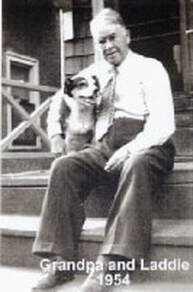
After Grandma Reese died, in 1943, Grandpa lived alone and worked as a civil engineer for the City of Virginia. He traveled to San Diego, to Mexico, and to Florida. He never went back to Wales.
About 1949 to 1954, Grandpa Reese lived with us after he suffered a heart attack. He helped take care of me on school days while my mom was working. His specialty for lunch was fried potatoes. I think it might have been his only culinary skill. In our small three bedroom house, Mom and I shared a bedroom, and Bob and Grandpa each had a room. It was a pretty crowded place.
Grandpa loved to tell stories and after school, I heard things that he had never told anyone else. He told me about the death of his tiny sister, Elizabeth, on the night before they sailed from England to America. She was two, and carried a candle up the stairs of a boarding house in Liverpool, where they spent the last night before sailing. Her nightgown caught fire and she burned to death. The family had to leave the next day on the ship where they had booked passage. It was a sad family secret that he had never told anyone else before, but he, at age 8, had strong memories of it.
Grandpa had a great sense of humor and liked to tease and chuckle about things. He always wore a suit with a vest, and dress shirt, the same clothes he had worn to work as a mine clerk and city employee. He surpassed his family roots and did not have to work as a miner down in the pit, but in an office. He loved Laddie, our old dog. The two old friends sat together many hours on the front steps of the house.
As his health got worse, he went to the Masonic Home in Richfield, Minnesota, to live the last years of his life. In 1954, Bob went off to college in Colorado and Grandpa moved to Minneapolis and the house had only two of us, Mom and me. Grandpa died in 1955, after suffering a stroke. Laddie died the same year.
About 1949 to 1954, Grandpa Reese lived with us after he suffered a heart attack. He helped take care of me on school days while my mom was working. His specialty for lunch was fried potatoes. I think it might have been his only culinary skill. In our small three bedroom house, Mom and I shared a bedroom, and Bob and Grandpa each had a room. It was a pretty crowded place.
Grandpa loved to tell stories and after school, I heard things that he had never told anyone else. He told me about the death of his tiny sister, Elizabeth, on the night before they sailed from England to America. She was two, and carried a candle up the stairs of a boarding house in Liverpool, where they spent the last night before sailing. Her nightgown caught fire and she burned to death. The family had to leave the next day on the ship where they had booked passage. It was a sad family secret that he had never told anyone else before, but he, at age 8, had strong memories of it.
Grandpa had a great sense of humor and liked to tease and chuckle about things. He always wore a suit with a vest, and dress shirt, the same clothes he had worn to work as a mine clerk and city employee. He surpassed his family roots and did not have to work as a miner down in the pit, but in an office. He loved Laddie, our old dog. The two old friends sat together many hours on the front steps of the house.
As his health got worse, he went to the Masonic Home in Richfield, Minnesota, to live the last years of his life. In 1954, Bob went off to college in Colorado and Grandpa moved to Minneapolis and the house had only two of us, Mom and me. Grandpa died in 1955, after suffering a stroke. Laddie died the same year.
Schumacher / Johnson / Reese Family Tree
Johnson / Reese Family Tree
John T Williams
John T Williams was born at Cwmsaethau Farm, Rhandirmwyn in 1839 a son of Barbara and Thomas Williams. He went to the local school. At the age of 16 he went to work at the Nantymwyn lead mine but in 1859 at the age of 20, John T. left for America, sailing from Swansea and landing four weeks later in New York. He settled in Scranton, Pennsylvania and worked at the Hampton Mine of the Delaware, Lockwana and Eastern Railroad Company. It was not long however before John T. was on the move once more, this time heading for California in search of gold. In 1861 he boarded a steam ship in New York and sailed via Panama to San Francisco. He remained in California for five years, mining at San Juan. It would seem that like many others he failed to find his fortune but John T. was not a man who gave in easily. He returned to Scranton and in 1867 he married Mary Lewis who was from Neath, Pennsylvania. Her family roots were in Trecynon, near Aberdare, Wales. They settled in Hampton Street, Scranton and had five children. John T. went back to work in the mines and became foreman. However he started to invest in mining and was described in one census as a landlord and capitalist. In 1874 he was one of the original stockholders when the West Side Bank was formed.
In 1884 after the death of his father John T. paid a visit to Rhandirmwyn to see his mother. Soon after he was nominated by the Republican Party as their candidate for the state legislator for Pennsylvania and was elected to this position by a 1300 majority. This position was a very responsible one and he was in reality a member of the government for the Sate of Pennsylvania with responsibility for the enactment of state laws.
In 1886 he embarked on a general mercantile business under the company name Williams and Co. He was in partnership with another John Williams, this time it was John H. Williams whose roots were also in Rhandirmwyn. It was a very successful venture. John T. was also director of the Scranton Packing Company and had large interests in coal mining. He was a director and treasurer of the Cambrian Mutual Fire Insurance Company.
In 1896 John T. was a delegate to the Republican National Congress which was held at St Louis where William McKinley was first nominated as the republican candidate for the President of the United States. He was elected in 1897 and was in office until 1901.
John T. became president of the West Side Bank and died in 1903.
(We are grateful to Martha Phillips, Scranton, John T. Williams’ granddaughter for this information).
In 1884 after the death of his father John T. paid a visit to Rhandirmwyn to see his mother. Soon after he was nominated by the Republican Party as their candidate for the state legislator for Pennsylvania and was elected to this position by a 1300 majority. This position was a very responsible one and he was in reality a member of the government for the Sate of Pennsylvania with responsibility for the enactment of state laws.
In 1886 he embarked on a general mercantile business under the company name Williams and Co. He was in partnership with another John Williams, this time it was John H. Williams whose roots were also in Rhandirmwyn. It was a very successful venture. John T. was also director of the Scranton Packing Company and had large interests in coal mining. He was a director and treasurer of the Cambrian Mutual Fire Insurance Company.
In 1896 John T. was a delegate to the Republican National Congress which was held at St Louis where William McKinley was first nominated as the republican candidate for the President of the United States. He was elected in 1897 and was in office until 1901.
John T. became president of the West Side Bank and died in 1903.
(We are grateful to Martha Phillips, Scranton, John T. Williams’ granddaughter for this information).
William R Lewis and Jane ‘Jenny’ Lewis
The stories of Jane ‘Jenny” Lewis and Judge. William Lewis,Troedrhiwfer, Rhandirmwyn
Researched by: W. J. Richards (Florida, USA) grandson of William R Lewis
This is the story of the descendants of Joseph and Ann Lewis (nee Vipond), Troedrhiwfer, Rhandirmwyn.
No other details of Joseph Lewis.
Ann Vipond believed to have been born in 1804. Possibly sister of William Vipond who has extensive history in America. For more information on Vipond Family please visit website www.vieuxpont.co.uk .
They had two children namely;
Thomas Lewis, born 1830.
Rhys ‘Rees’ Joseph Lewis born in February 1832 in Rhandirmwyn.
On 16th November 1853 at Cil-y-cwm, Rhys Joseph Lewis married Anne Jones. She had been born in 1832 in the Parish of Cil-y-cwm..
They had the following children:
i. Joseph R. Lewis (1854) ii. Mary Lewis (1856). iii. Ann "Annie" Lewis (30 Nov 1858)
iv. Jane "Jennie" Lewis (1862). v. Catherine "Kate" Lewis (3 Oct 1864). vi. William R Lewis (26 Feb 1867).
The family emigrated to America and settled in the City of Scranton, State of Pennsylvania.
Rhys Joseph Lewis who had worked in the Nantymwyn Lead Mine, Rhandirmwyn had emigrated to dig mine shafts in the Scranton area.
In 1869 soon after arriving in America his wife, Anne died. She was 37 years old. He never remarried and the siblings were brought up by his eldest daughter Mary.
Rhys died on 15th June 1887 in Scranton, Pennsylvania.
All the children married and raised families and their descendants are living in America.
This is the story of two of the children, namely Jane ‘Jennie’ Lewis and William R Lewis Both became well known and respected citizens of Pennsylvania.
Jane was very active in the Order of Eastern Star and Republican Party. (The Order of the Eastern Star is the largest womens organization affiliated with the Masonic organizations. Perhaps she was the first woman delegate to the Pennsylvania Republican Convention. She was an outstanding business woman and founder of Lewis & Reilly, Inc. in Scranton. This was a large shoe retail business that opened its doors for the first time on December 15th 1888. She married Elias Evans late in life and had no children of her own. She died on 17th December 1940 in Scranton. The business was finally dissolved in 1987 just shy of its 100th anniversary.
On 20th June 1894 William R. Lewis married Josephine Lloyd a lady born in Scranton of Welsh parents, Joseph D. Lloyd and his wife Hannah (nee Jones), on 7th September 1869.
William graduated from the State Normal School now Bloomsburg State Teachers College in 1886 and finished the 2 year course in 3 semesters as he had insufficient funds for 2 years. He served as Deputy Prothonotary (The principal clerk in certain courts of law) under Thomas H. Dale. He clerked in law offices of Judge Gunter, Judge Alfred Hand, and William J. Hand until admittance to the bar in 1893. He served as District Attorney of Lackawanna County from 1901-1906.
He practiced law with his partner Herbert Taylor for many years in the firm of Taylor & Lewis. He ran unsuccessfully for judge but was appointed to fill the unexpired term of Judge Maxey by Governor John Fisher on December 9, 1930. Was successfully elected to a second term as Judge in the Court of Common Pleas in 1932 (Governor Gifford Pinchot signed his commission) and died from a heart attack (coronary thrombosis) soon after his retirement from office on September 17, 1942. His portrait formerly hung in Court Room No. 1 of the Lackawanna County Court House in Scranton, but now hangs in the Family Law court room in the Administrative Law Building in Scranton.
He was a very successful lawyer and businessman. William owned coal mines in Illinois and was owner with his sister Jane in the shoe business, Lewis & Reilly, Inc. Had a reputation of great honesty as a lawyer & jurist. He could speak Welsh but did not speak it with his children as he felt English was spoken in America, but he was active in Welsh circles and was a Mason. He belonged to the Welsh Baptist Church of Scranton and an active church participant until children were born, then he used Sundays to work around the home and parenting. He had a habit of walking down the street with his hands clasped behind his back. He did not drive a car, but had a chauffer, ‘Shink’ Davis, or his daughter Gertrude drove.
William and Josephine had the following children They had the following children all born and died in Scraanton: Hannah (1896-1897), Mary Lloyd Lewis (1898-1954), Ruth Josephine (1901-1988), Gertrude (1905-1960), and William (1910-1911). Only Ruth married and had one son, William ‘Bill’ Joseph Richards, who supplied this information.
We are very grateful to Bill for supplying the information about the Lewis family. There is much more which has not at this stage been included on the website. We are in the process of compiling the Lewis Family Tree. If you are researching the Lewis Family from Rhandirmwyn and you need further information please contact the website or Bill at [email protected]
Researched by: W. J. Richards (Florida, USA) grandson of William R Lewis
This is the story of the descendants of Joseph and Ann Lewis (nee Vipond), Troedrhiwfer, Rhandirmwyn.
No other details of Joseph Lewis.
Ann Vipond believed to have been born in 1804. Possibly sister of William Vipond who has extensive history in America. For more information on Vipond Family please visit website www.vieuxpont.co.uk .
They had two children namely;
Thomas Lewis, born 1830.
Rhys ‘Rees’ Joseph Lewis born in February 1832 in Rhandirmwyn.
On 16th November 1853 at Cil-y-cwm, Rhys Joseph Lewis married Anne Jones. She had been born in 1832 in the Parish of Cil-y-cwm..
They had the following children:
i. Joseph R. Lewis (1854) ii. Mary Lewis (1856). iii. Ann "Annie" Lewis (30 Nov 1858)
iv. Jane "Jennie" Lewis (1862). v. Catherine "Kate" Lewis (3 Oct 1864). vi. William R Lewis (26 Feb 1867).
The family emigrated to America and settled in the City of Scranton, State of Pennsylvania.
Rhys Joseph Lewis who had worked in the Nantymwyn Lead Mine, Rhandirmwyn had emigrated to dig mine shafts in the Scranton area.
In 1869 soon after arriving in America his wife, Anne died. She was 37 years old. He never remarried and the siblings were brought up by his eldest daughter Mary.
Rhys died on 15th June 1887 in Scranton, Pennsylvania.
All the children married and raised families and their descendants are living in America.
This is the story of two of the children, namely Jane ‘Jennie’ Lewis and William R Lewis Both became well known and respected citizens of Pennsylvania.
Jane was very active in the Order of Eastern Star and Republican Party. (The Order of the Eastern Star is the largest womens organization affiliated with the Masonic organizations. Perhaps she was the first woman delegate to the Pennsylvania Republican Convention. She was an outstanding business woman and founder of Lewis & Reilly, Inc. in Scranton. This was a large shoe retail business that opened its doors for the first time on December 15th 1888. She married Elias Evans late in life and had no children of her own. She died on 17th December 1940 in Scranton. The business was finally dissolved in 1987 just shy of its 100th anniversary.
On 20th June 1894 William R. Lewis married Josephine Lloyd a lady born in Scranton of Welsh parents, Joseph D. Lloyd and his wife Hannah (nee Jones), on 7th September 1869.
William graduated from the State Normal School now Bloomsburg State Teachers College in 1886 and finished the 2 year course in 3 semesters as he had insufficient funds for 2 years. He served as Deputy Prothonotary (The principal clerk in certain courts of law) under Thomas H. Dale. He clerked in law offices of Judge Gunter, Judge Alfred Hand, and William J. Hand until admittance to the bar in 1893. He served as District Attorney of Lackawanna County from 1901-1906.
He practiced law with his partner Herbert Taylor for many years in the firm of Taylor & Lewis. He ran unsuccessfully for judge but was appointed to fill the unexpired term of Judge Maxey by Governor John Fisher on December 9, 1930. Was successfully elected to a second term as Judge in the Court of Common Pleas in 1932 (Governor Gifford Pinchot signed his commission) and died from a heart attack (coronary thrombosis) soon after his retirement from office on September 17, 1942. His portrait formerly hung in Court Room No. 1 of the Lackawanna County Court House in Scranton, but now hangs in the Family Law court room in the Administrative Law Building in Scranton.
He was a very successful lawyer and businessman. William owned coal mines in Illinois and was owner with his sister Jane in the shoe business, Lewis & Reilly, Inc. Had a reputation of great honesty as a lawyer & jurist. He could speak Welsh but did not speak it with his children as he felt English was spoken in America, but he was active in Welsh circles and was a Mason. He belonged to the Welsh Baptist Church of Scranton and an active church participant until children were born, then he used Sundays to work around the home and parenting. He had a habit of walking down the street with his hands clasped behind his back. He did not drive a car, but had a chauffer, ‘Shink’ Davis, or his daughter Gertrude drove.
William and Josephine had the following children They had the following children all born and died in Scraanton: Hannah (1896-1897), Mary Lloyd Lewis (1898-1954), Ruth Josephine (1901-1988), Gertrude (1905-1960), and William (1910-1911). Only Ruth married and had one son, William ‘Bill’ Joseph Richards, who supplied this information.
We are very grateful to Bill for supplying the information about the Lewis family. There is much more which has not at this stage been included on the website. We are in the process of compiling the Lewis Family Tree. If you are researching the Lewis Family from Rhandirmwyn and you need further information please contact the website or Bill at [email protected]



